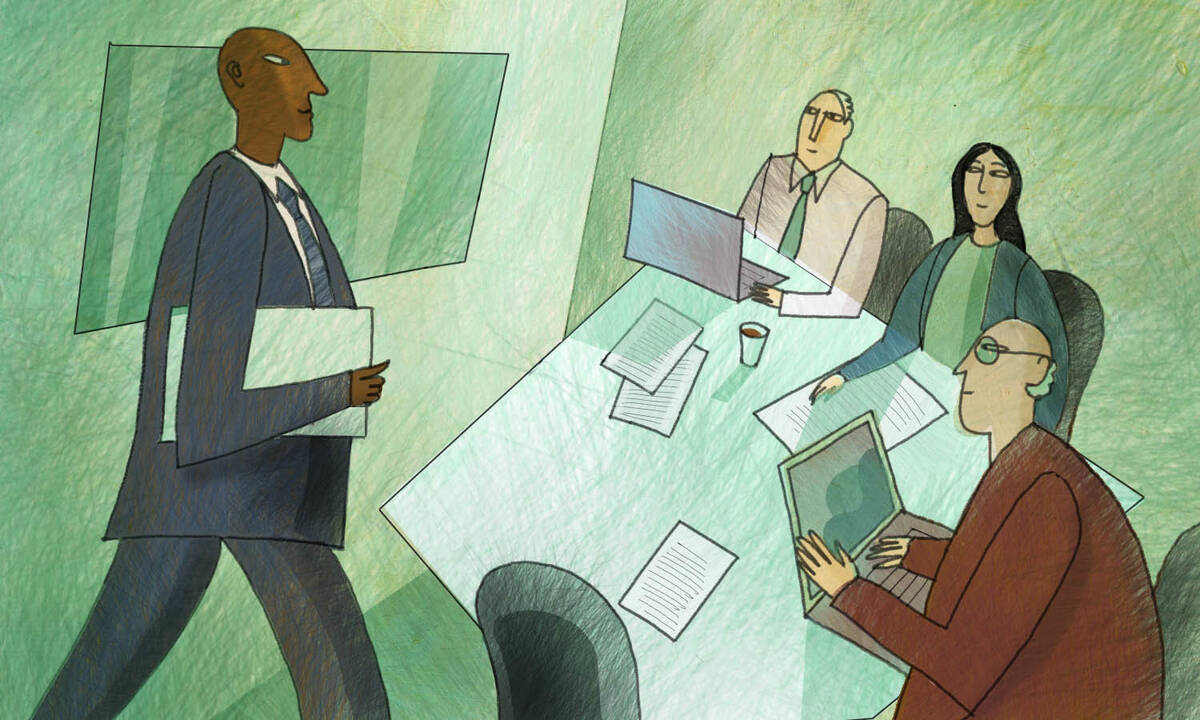Social Impact Leadership Jun 16, 2020
“This Is What It Means to Be Black in America and Black in Corporate America”
As the nation reckons with structural racism, a Kellogg professor and a Google diversity recruiter discuss what credible leadership looks like for business leaders.
This audio is powered by Spokn.

Yevgenia Nayberg
In recent weeks, the killings of unarmed Black citizens by police have prompted widespread outrage and calls for change—and not just to the criminal justice system. Business leaders are also being asked to take bold action to dismantle racism, and in particular anti-Black racism, in America.
So what might that look like in practice?
Ginny Clarke serves as the head of leadership staffing at Google and an expert on diversity recruitment. She’s also a Kellogg alumna. Earlier this week, Clarke spoke with Nicholas Pearce, a clinical professor at Kellogg who also serves as a pastor and consultant.
Clarke and Pearce pinpoint the deep-rooted barriers that keep organizations from achieving true diversity and equity. And they discuss how leaders must use this moment to reflect, to learn, and to make real strides toward racial justice going forward.
This conversation has been edited for length and clarity. (You can hear more of their conversation in the latest episode of The Insightful Leader podcast.)
Ginny CLARKE: I think diversity, equity, and inclusion (DEI) has become an office or a function or a center of excellence in most organizations. But my concern is, a lot of these programs are not embedded. And the cynic in me, having done this work now for 25 years, says it can become a bit of a dumping ground for everything that senior leaders don’t necessarily want to have to deal with. “Here, fix this. We don’t have representation here. You fix this for us. Fill the supply of underrepresented talent.” When in fact those aren’t the root-cause issues that are getting in the way of having representation.
Because when you look at the engagement surveys at Google and at other companies, you see great disparities in the way that people of color are experiencing the organization. My concern around the DEI efforts is that those people leading them—great, successful competent individuals in those chief diversity officer roles—don’t necessarily have the authority to impact change.
Nicholas PEARCE: So you are arguing to an extent that perhaps these roles as they are currently constituted are being set up to fail, which I think is one of the factors that has led CEOs to look at those roles as expendable in the COVID moment, when the organization is trying to focus on their most pressing basic needs for survival and for solvency.
Yet I think there’s a pretty significant miscalculation on these leaders’ parts, because none of the reasons why diversity and inclusion mattered before COVID have gone away. Without diversity, inclusion, and equity efforts, you stand to receive quite a bit of backlash from your customers, backlash from your employees. You will suffer from less innovation. You will suffer from less thoughtful decision-making processes. You will have less customer insight. Your diverse talent will ultimately be alienated.
Now let’s add to that what some people are calling the COVID 1619 pandemic, right? So if we think about COVID-19 as the novel coronavirus, the COVID 1619 pandemic is referring to racism as a pandemic that has been running in the American background and in the foreground for 400 years.
And so now after centuries of state-sanctioned Black suffering, now in the wake of the executions of Ahmaud Arbery in South Georgia, and Breonna Taylor in Louisville, Kentucky, and George Floyd in Minneapolis, Minnesota, cries for justice have turned to demands for justice. And those have turned to outrage and widespread protests across the country and around the world. Now companies are thinking, “We better do something. So let’s go get those diversity folks whom we didn’t really value that highly and get them to craft a message or plan something, or help us put an ad campaign together, help us to make a social media post for Blackout Tuesday.”
How do you make sense now of not just diversity in the COVID-19 moment, but diversity and inclusion in the COVID 1619 pandemic? What does credible leadership look like?
CLARKE: I think credible leaders look like they’re having some of those difficult conversations that they’ve simply not had before.
And I’ve had people say, “What should I be doing?” And I almost feel like it’s a bit of a cop out, but I try to offer something: “You know what, go educate yourself on Black history in this country; go learn what the year 1619 means. And go watch something like 13th by Ava DuVernay to understand mass incarceration and the historical references and implications of Jim Crow.” To me, that’s the stuff that a credible leader needs to do before they just try to say, “What should I be saying to the external market.” There’s got to be a real, genuine sentiment here.
“The chief diversity officer cannot be employed simply to be the conscience of the CEO.”
— Prof. Nicholas Pearce
PEARCE: I agree that this is a raw moment. It is a difficult moment. I have also received many phone calls and emails, mostly from white colleagues or white clients of my consulting company, that are looking for some absolution of their guilt. And in many cases, what I have found is that they have not taken the time to educate themselves about the issues.
But when you say what credible leaders should be doing is learning and educating themselves and watching 13th, it’s hard for me because a lot of people will study the issue to death and do nothing about it. And people will say, “Well, as long as I lead with empathy and issue a heartfelt statement that conveys my deep, deep hurt and pain, then I have done my job.” And the reality is that is not at all the totality of the job. The job of leaders is to first connect, but then lead.
Writing an email or a letter conveying your thoughts and prayers is an initial act of leadership, but that is something that anyone can do. What leaders must do, in my opinion, is to take stock of the social, political, organizational, economic, and other sources of capital at their disposal and deploy it in ways that are just. Which is why I would think that this moment is not so much a diversity-and-inclusion issue, as much as it is a moral-leadership issue.
Which gets back to your point about CEOs wrongly outsourcing a lot of this to chief diversity officers. I’m not saying that the chief diversity officer has no role. What I am saying is that the chief diversity officer cannot be employed simply to be the conscience of the CEO.
CLARKE: And there’s an individual level of awareness that each of us needs to come to grips with. And it means facing your own biases. Facing your own fears, your own trauma, your own angst, all of that stuff. Everybody’s bringing their baggage and beliefs. Black people included! Everybody needs to come clean with themselves in this moment and really get deep down and real. Have a conversation with yourself about what you believe, and stop hiding behind the corporate culture and that little veil of protection that you think keeps you absolved. Stop living in the denial that this isn’t your problem. It is. It’s everyone’s problem. And we each need to come clean with ourselves on a very profound level before we’re going to go out into the world and try to create a systemic change.
PEARCE: I love that. A lot of my students sign up for my diversity class because they want to learn the how-tos. They want to learn how to build stronger organizations, how to build a diversity strategy, how to leverage diverse talent—how to, how to, how to. And where I start them is not giving them the how-tos. I start them with the opportunity to first examine who they are as individuals.
Because each of us brings, as you said, baggage. Each of us brings life experiences. Each of us brings a number of social identities to the table. And a lot of us are suppressing the true self by not coming to terms with who we are. A lot of us are hiding behind the mask, sending a representative of ourselves to work every day. And I think that first being able to own the fact that each of us has a diversity story of some sort, each of us has things we are afraid of, things that we are perhaps ashamed of, things that we are joyous about, things that we are saddened by. And by being able to engage in the radical act of self-acceptance and self-disclosure in a safe environment, that positions us to then have conversations about, “How do I navigate interactions in such a way that I am building an inclusive environment?”
“You want to talk about hearing and understanding? Understand what it looks like for me to come into organizations and have people assume that I’m not as smart as my resume would show.”
— Ginny Clarke
CLARKE: In my 35-year career, I have had to assimilate to work in the companies that I work for. Chase, Prudential, JLL, Spencer Stewart, all of these big organizations: there is a quiet—and sometimes not-so- quiet—expectation that I had to show up in a certain way in order to be successful in that organization. And there are aspects of “who Ginny Clarke is” that simply have not been welcome. Let’s just call that what it is.
Do you know the toll that that’s taken on me? Thank God that God made me resilient, that I am the descendant of slaves who were extremely resilient. It’s my resilience that has allowed me to live in both worlds, but it’s taken a toll. And thank God I’m able to go into my meditative space to fortify myself during these most difficult times, because this is what I don’t think a lot of people understand and appreciate. This is what it means to be Black in America and Black in corporate America. You want to talk about hearing and understanding? Understand what it looks like for me to come into organizations and have people assume that I’m not as smart as my resume would show. Or, because I show up as highly competent, which I am, somehow that makes them uncomfortable because of their incompetence in certain areas. And that becomes my problem. And I thereby get held back because I make other people uncomfortable. This is what we need to be talking about, because that is what leaders need to understand: that they have been complicit in allowing people to treat me and others as though we were less-than because we made them feel uncomfortable. That’s their stuff. It’s like, “you need to come clean with you and your insecurities because you’re imposing them on me. I’ve dealt with mine in order to show up in this environment year after year after year. What are you going to do?”
Hear more of this conversation—including some concrete steps organizations can take—on the latest episode of The Insightful Leader.



